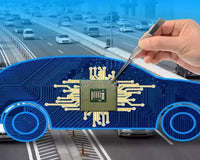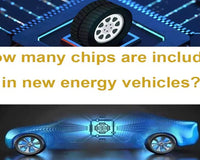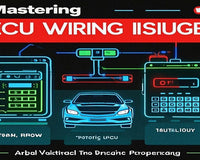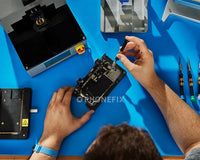
Electronic car keys have gone through two main phases. The first is a blend of physical and electronic known as transponder keys or chip keys. And the most recent trend is to make the key completely virtual with the use of a car key fob, which has no blade.
1. Transponder Car Keys
If you have an ignition key with a metal blade, take a look at the bow of the key. The bow is the wide circular or rectangular part you grip to turn the key when it is inserted. Sometimes the bow has a car key remote built into it, other bows will have a plastic cover (most often black).
The transponder chip for a key will be placed inside one of these bow covers. Therefore, these covers are the best visible indicator that you will need transponder key programming if you are replacing this type of key.

2. Car Key Fob
If you have a car key fob to start your vehicle, you don’t need to look at the key. Rather, take a look at your ignition. If it is a push to start button rather than a keyhole, then you know you are dealing with a key fob. But it can be trickier to reprogram car key fobs because they have more potential security controls.

Different vehicles use different types of keys, including traditional keys, transponder keys, and smart keys. The programming method may vary based on the key type and the vehicle's make and model.
Onboard Programming: Some vehicles allow for onboard programming, which means you can program a new key using an existing one without special tools.
Programming steps:
1. Refer to the owner manual for the specific process for your vehicle.
2. You will insert the working spare key into the ignition.
3. Manipulate the working spare key until the car enters programming mode.
4. Doors may need to be opened and closed.
5. Programming mode will be denoted by the locking of car doors, flashing dashboard readouts, or some other visual or sound to show the process worked.
6. Insert the new key (currently not programmed properly).
7. Manipulate the new key as directed by manual.
8. Exit programming mode
9. Often done by removing the key.
10. Test the new key.

OBD2 Programming: For newer vehicles or those without onboard programming capabilities, OBD2 programming may be required.
Programming steps:
1. Connecting a Smart Key Maker Programmer to the OBD2 port of your vehicle.
2. Following the device's instructions to program the new key.
3. Look to see if your car has a self-programming procedure.
4. With cars made after 2010 or luxury manufactures, this is exceedingly rare.
5. If the car has a self programming method, refer to documentation for specific methodology.
6. Without DIY programming, use a code capture device.
7. With a working remote, you can capture the signal and program it to your new remote.
8. If you do not have access to a code capture device, call a locksmith.

The DIY methods to reprogram car keys will nearly always need a spare car key to get the new key working properly. And it is becoming rarer and rarer for it to be possible to reprogram car keys yourself. And in some cases, programming will be so restricted that only the dealerships can make new keys.
Reprogramming car keys that are already programmed can be a straightforward process, depending on your vehicle's make and model. Some cars allow for DIY reprogramming through specific instructions found in the owner's manual. However, many modern vehicles require professional assistance from a locksmith or dealership due to the need for specialized car key programmer. It's important to check if your car supports onboard programming or if professional help is necessary to ensure the key is correctly reprogrammed.










